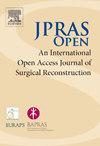Selective mid-facial neurectomy using intraoperative nerve monitoring system for post-facial paralysis synkinesis
IF 1.5
Q3 SURGERY
引用次数: 0
Abstract
Selective neurectomy of facial nerves is a treatment for post-facial paralysis synkinesis (PFS), which is a sequela of facial paralysis. Each branch of the facial nerve is stimulated during surgery, and nerve resection selection is determined based on the macroscopic findings. However, accurate assessment of the extent to which each nerve branch innervates a mimetic muscle is difficult. This may result in PFS recurrence or worsening of paralysis after surgery. Herein, we report a case of selective mid-facial neurectomy for PFS using an intraoperative nerve monitoring system.
A 60-year-old man presented with right-sided facial paralysis secondary to Hunt's syndrome. Two years after onset, the oral-ocular synkinesis worsened and the eyelids were closing completely during lip puckering. Therefore, we performed selective mid-facial neurectomy using an intraoperative nerve monitoring system.
During surgery, a skin incision was made from the temporal to the submandibular region, and the facial flap was elevated over the superficial musculoaponeurotic system (SMAS). Several nerve branches were identified by dissection of the area under the SMAS at the anterior border of the parotid gland. We stimulated each nerve branch while monitoring the orbicularis oculi, zygomaticus major, and orbicularis oris muscles. When certain nerve branches were stimulated, some of their mimetic muscles contracted. These branches were resected as they were thought to be responsible for PFS. The patient exhibited no obvious signs of PFS recurrence or worsening of paralysis at 3 months postoperatively. We believe that the intraoperative nerve monitoring system ensures the effectiveness and safety of selective mid-facial neurectomy.
求助全文
约1分钟内获得全文
求助全文
来源期刊

JPRAS Open
Medicine-Surgery
CiteScore
1.60
自引率
0.00%
发文量
89
审稿时长
22 weeks
期刊介绍:
JPRAS Open is an international, open access journal dedicated to publishing case reports, short communications, and full-length articles. JPRAS Open will provide the most current source of information and references in plastic, reconstructive & aesthetic surgery. The Journal is based on the continued need to improve surgical care by providing highlights in general reconstructive surgery; cleft lip, palate and craniofacial surgery; head and neck surgery; skin cancer; breast surgery; hand surgery; lower limb trauma; burns; and aesthetic surgery. The Journal will provide authors with fast publication times.
 求助内容:
求助内容: 应助结果提醒方式:
应助结果提醒方式:


